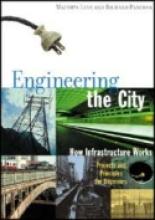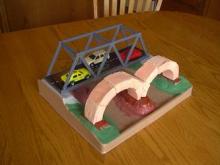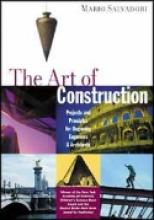Engineering
Engineering the City
Reading Level: Ages 9-12
I must admit that this is not a topic in which I am particularly interested. I'm very secure knowing that the water will be available when I turn on a tap or that the bridge I'm driving over will hold me.I'm not sure if I want to know what happens after I flush a toilet or where the garbage goes. That being said, this book helped me to understand these mundane things using terms that are easily understandable, describing activities that encourage further learning, and showing pictures that are clean and clear and make their point.
This book would make a great secondary resource for high school level physics, engineering or civics courses in that it helps define and explain how the things we take for granted work – why there are different bridges for different applications; what the water table is and why it's important; ways and means of transporting citizens; and many other topics. The simple line-drawn diagrams and illustrations ease understanding of some of the more technical information. Published by Chicago Review Press, this book is supposedly for 9-year-olds and up. I think, unless your middle school student is very "into it", this resource would be better suited to high school students. Some of the activities are a bit blah or extremely elementary, but taking into consideration the subject matter, the activities do help illustrate the concept or principle described in the accompanying text.
Chapters include: water, transportation by water, irrigation, different ways of transportation, trains of all types, different styles of bridges, wires/telephones and wireless communication, plumbing and sewers, refuse disposal or reuse, and pollution from acid rain, global warming and water pollution. This book would make a great text for a co-op class of high schoolers; the projects done in a group setting with a bit of competition thrown in. For instance, to illustrate the concepts from the chapter on different styles of bridges, a bridge-building contest using the designs described would be great. This book would also be suitable for ideas for science fair projects.
Our Amazing Bridges
Bridge-Building Kit
The Art of Construction
Reading Level: Ages 9-12
The Art of Construction (originally published in 1979 under the title Building: The Fight Against Gravity) is one of the finest examples of books that help children understand principles of science as applied to real life situations - in particular buildings and making sure that they stay up in spite of gravity and natural disasters.
Children are introduced to important concepts like "tension" and "compression" with simple hands on exercises to help understand and remember them. Most chapters include a somewhat-more-involved construction project to teach these principles (and have a lot of fun in the process). Numerous illustrations make concepts and clearer and aid in understanding the building projects.
The text is very engaging and easy-to-understand. We've found it ideal as a read-aloud with a group. Our co-op has been using it somewhere in the 2nd to 4th grade range, although it could certainly used by much older students (all the way through high school would be reasonable). The engineer dads in our co-op have been very impressed with the book and the concepts the children study.
The chapter titles are as follows (and give you a little glimpse of the content and style):
- From Cave to Skyscraper
- Building a Tent
- What is a Beam?
- What do We Build Structures With?
- The Floor of Your Room
- A Steel Frame...Made Out of Paper
- The Part of the Building You Don't See
- What Tornadoes, Earthquakes and Changes in Temperature Can Do
- How to Fight Tornadoes and Earthquakes
- Ropes and Cables
- Sticks and Stones
- Strings and Sticks
- Shape and Strength
- Barrels, Dishes, Butterflies, Bicycles Wheels and Eggs
- Balloons...and Back to the Tent
"If you had one of your friends put your hands on each other's shoulders and move your feet away from each other, you will become a full arch and feel compressed by each other's weight. But if your shoes slip on the floor and you begin to slide apart, the arch will collapse. Its ends must be firmly anchored to prevent it from spreading apart." (pg. 15)
"The best way to understand how the frame of a building works is to build one. A good model of a steel frame can be built with paper, provided we first build the separate elements of the frame: the columns, the beams, and the floors. A column should not take too much floor room, but must be strong enough to carry the compressive loads without buckling under them. A column buckles, that is, bends under compression along its axis, if it is too thin. Take a plastic ruler, stand it up, and push downward on it: there comes a point when the ruler will bend out." (page 39)
"The purpose of a building's structure is to guarantee that the building will stand up under all the loads and forces acting on it: the weights, the pressure of the wind, the forces due to temperature changes, and, possibly, the shaking caused by earthquakes. The builders want to make sure that the building will not collapse, and they hope it will not even be damaged, since in the first case it may kill people and in the second it may be costly to repair. They also want to make sure that the building will not move around. If a house were to slide down the slope of the hill it is built on, or if a skyscraper were to be toppled by the wind, the buildings would have failed their purpose, even if their structures might sometimes ed up undamaged." (page 57)
This is one of the books that I want to be sure each of my children have a chance to study sometime during their school years. Highly recommended!



